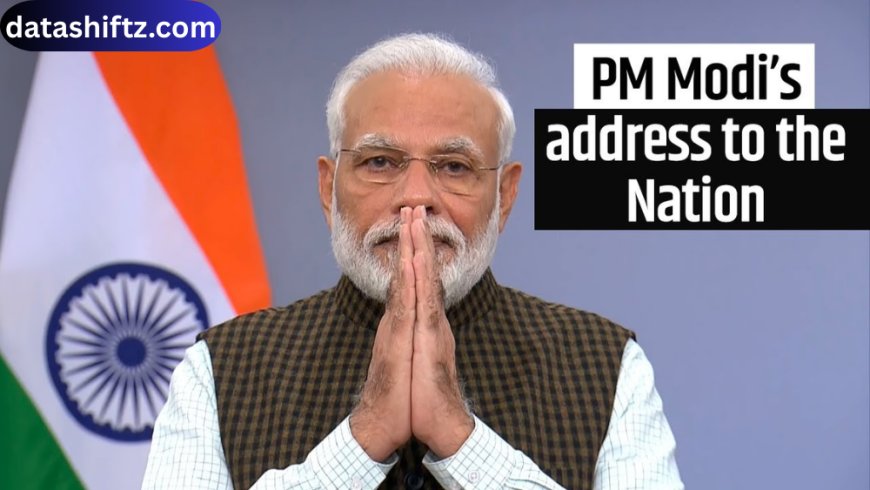Modi to Address Nation: What’s in Store & What It Means

Prime Minister Narendra Modi is set to deliver a nation‑address on September 21, 2025, at a time of significant economic, diplomatic, and domestic shifts. The address is expected to bring important policy changes affecting millions of Indians, particularly in the realms of taxation (GST), trade, and self‑reliance (“Atmanirbhar Bharat”). Given global trade pressures, especially with tariff impositions by the United States, Modi’s call for local manufacturing and Swadeshi goods is gaining renewed emphasis. As citizens wait for the address, analysts and political observers are dissecting what’s likely to come—and what challenges lie ahead.
This article examines the context of the address, key expected announcements, possible implications, and what to watch out for.
Context & Background
Geopolitical & Economic Pressures
-
Trade tensions with the U.S.: India is facing raised tariffs on some goods, prompting concerns about export competitiveness and supply chain vulnerabilities.
-
Domestic cost of living & tax burdens: Rising costs and complex tax structures (multiple GST slabs, previous tax rates) have been a subject of debate and political pressure.
Political Timing & Festivals
-
The address is happening just before Navratri, a significant festival in India. Launching reforms and relief at a time when consumer sentiment is high could help with acceptance.
-
Opposition criticism over tax burdens (notably the “Gabbar Singh Tax” label for GST by critics) is being addressed in advance. Modi is set to clarify and counter these claims.
Expected Key Announcements
Based on recent reports, here are the major items expected to feature in Modi’s address:
GST Reforms & Tax Relief
-
GST 2.0 and “GST Bachat Utsav” to begin September 22, 2025. Reforms likely to simplify GST rate structures and reduce tax on many everyday goods and services.
-
Cuts in GST or reclassification of goods, targeted relief for poor and middle‑class households.
Promotion of Atmanirbharta & Swadeshi Goods
-
Modi is expected to urge citizens to reduce reliance on imported goods, and prefer “Made in India” or Swadeshi products. This goes along with promotion of local manufacturing, including MSMEs (Micro, Small & Medium Enterprises). Possibly some measures to support domestic industries under pressure from external tariffs.
Expected Features vs. Potential Impacts
| Feature of Address | What Might Be Announced | Potential Impact on Citizens/Businesses |
|---|---|---|
| GST Reform (2.0) & Rate Cuts | Reduction/realignment of slabs, simplification, relief for basic goods | Lower prices for everyday items; easier compliance for small businesses |
| Tax Relief Measures | Income tax adjustments, exemptions or rebates | Increased disposable income; boost in demand |
| Push for Swadeshi / Atmanirbharta Bharat | Incentives for local production; buy‑Indian campaigns | Opportunities for local manufacturers; job creation |
| Response to Opposition’s Criticism | Clarification about GST being not “new” but replacing older taxes like VAT etc. | Public trust; political debate cooled; clarity in tax policy |
| Trade & Import Tariffs | Measures to shield sensitive sectors; perhaps support for exporters | Protection for domestic industries; potential retaliation risks |
Reactions & Controversies
With big announcements come reactions. Here's what is being said and expected:
-
Opposition parties have labelled GST reforms under Modi as being too little or too late. The “Gabbar Singh Tax” accusation (that taxes are high and burdensome) is being directly addressed in this speech.
-
Analysts expect that while tax relief is welcome, it must be balanced with revenue needs; too many rate cuts without compensatory increase in revenue elsewhere could strain state finances.
-
Citizens will be watching whether the reforms translate into real price drops—not just on paper—particularly for essentials.
-
Trade & foreign policy watchers are also expecting hints on how India plans to respond to global tariff pressures and whether there will be diplomatic or trade retaliation or mitigation.
What to Watch During & After Modi’s Address
Here are key items for citizens, businesses, and policy analysts to pay attention to:
-
Effective Date
When do the GST changes start? Reports suggest September 22, 2025. -
Goods & Services Affected
Which everyday items will see tax cuts or structure changes (kitchenware, clothing, electronics etc.) -
Benefit to Lower & Middle Income Groups
How much relief is being extended to poorer sections of society? -
Support for Local Industry & MSMEs
What subsidies, incentives, or policy changes are offered to make Indian manufacturing competitive. -
Compliance Simplification
Whether steps like easier tax filing, less paperwork, fewer slabs will be introduced. -
Addressing Opposition Concerns
How PM responds to critiques — such as GST being burdensome or not benefiting common people. -
International Implications
Trade policy signals—tariff mitigation, import‑substitution, export support—given rising global economic tensions.
Conclusion:
What Modi’s Address Might Mean for India
Modi’s upcoming address is more than just a speech—it’s likely to serve as a significant pivot point in India’s economic policy. With GST reforms, emphasis on self‑reliance, and nationalist overtones (Swadeshi), the government appears to be doubling down on policies that blend economic liberalization with protection of domestic interests.
If the announced measures are implemented smoothly, there could be genuine easing of the tax burden on millions, a boost to local manufacturing, improved business climate especially for MSMEs, and stronger economic confidence. On the flip side, the challenges will be in execution: ensuring that tax cuts don’t lead to revenue shortfalls, that price reductions happen for consumers, and that trade retaliation doesn’t unsettle impacted sectors.
For citizens, businesses, and political actors alike, this address will be a yardstick: measuring how policy aligns with promise, and how much of the rhetoric transforms into real improvement in everyday lives.






























